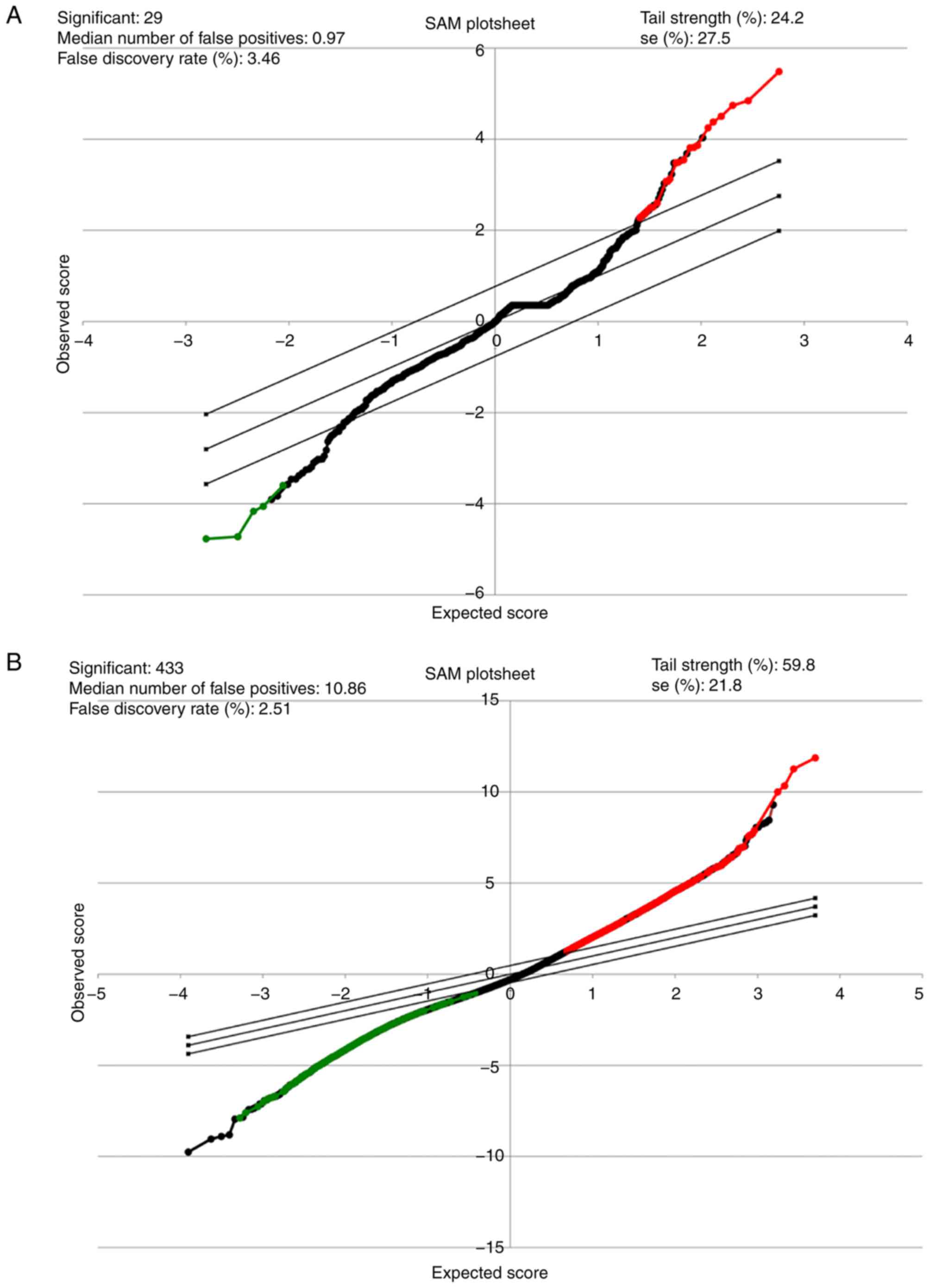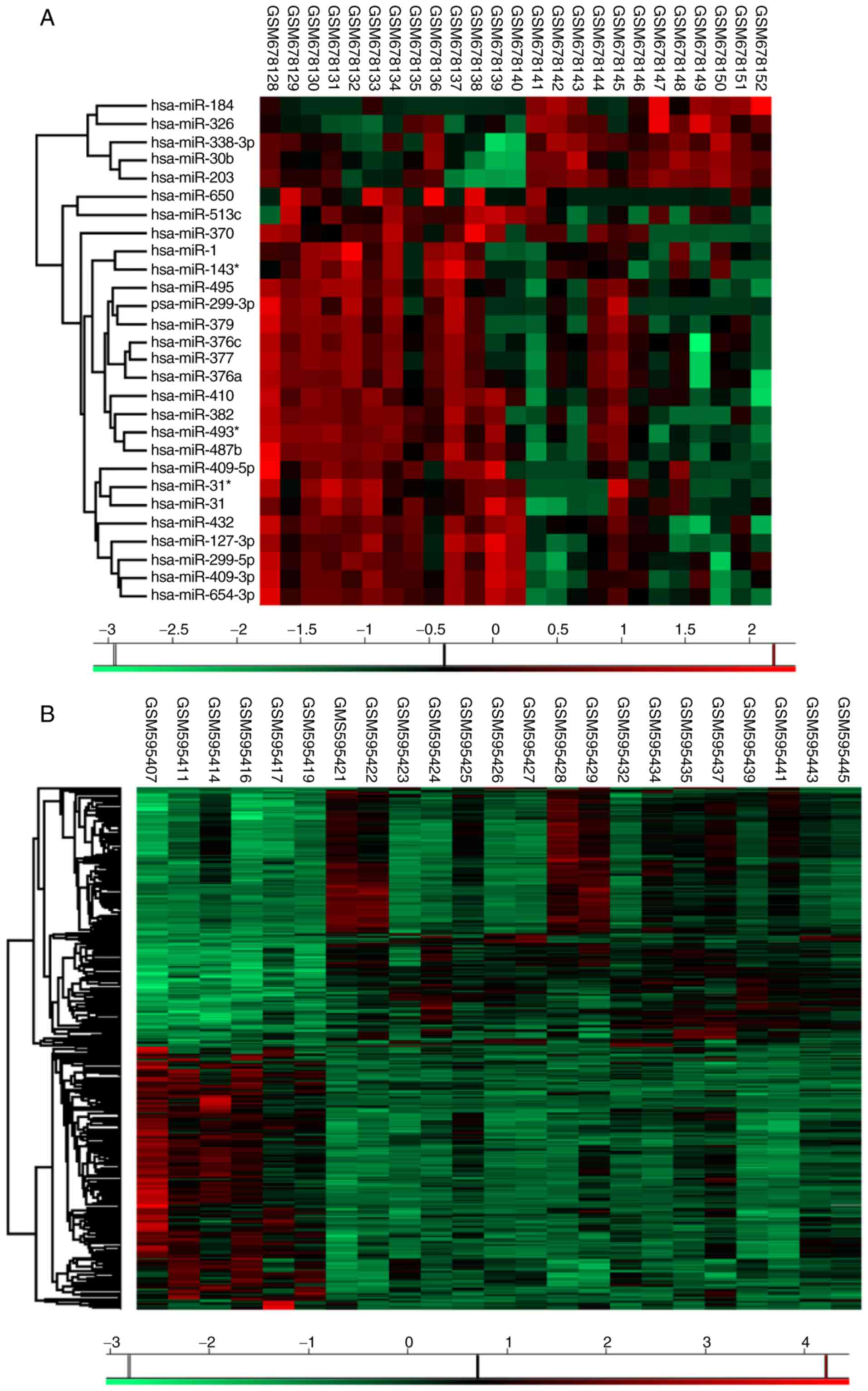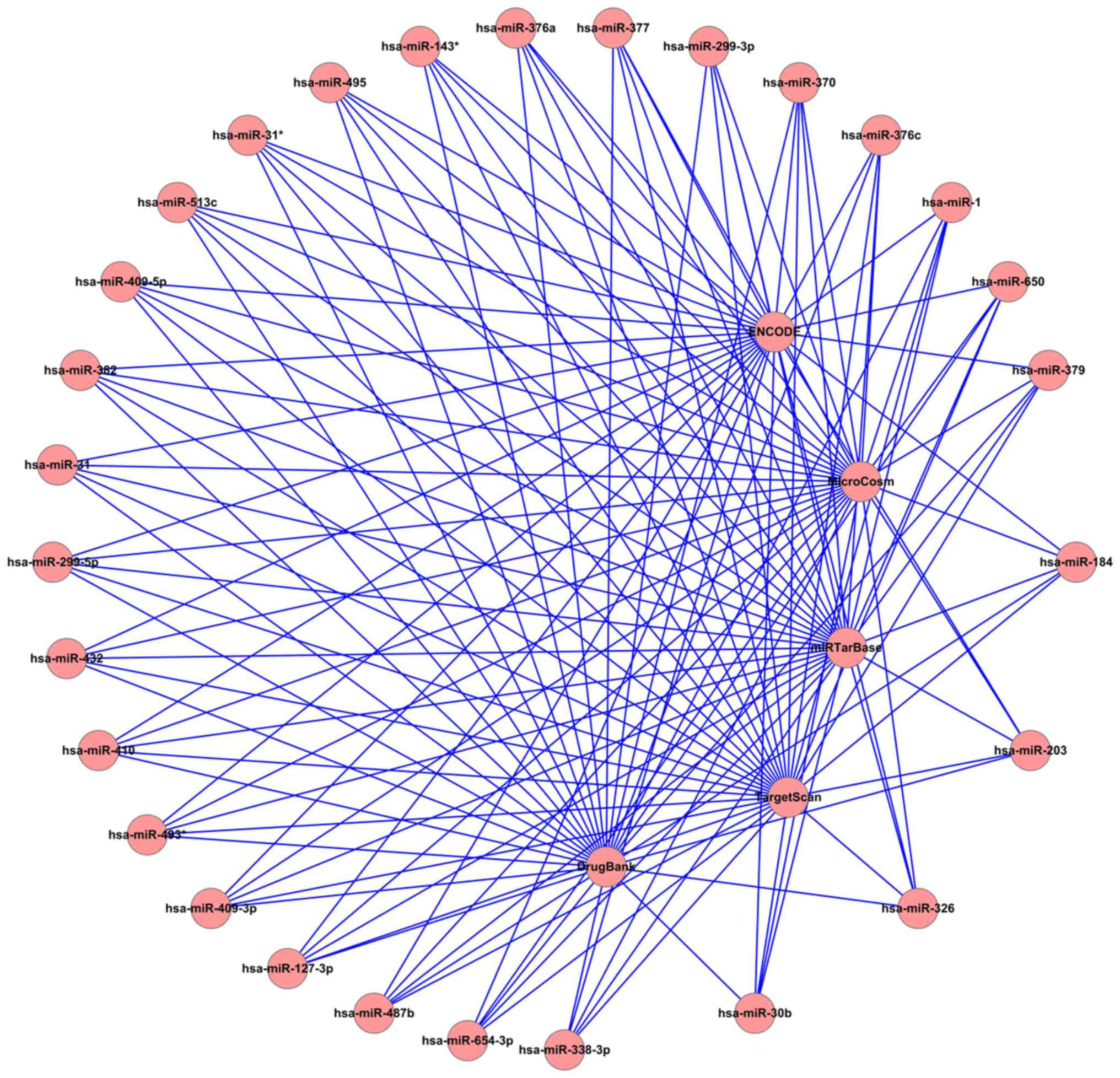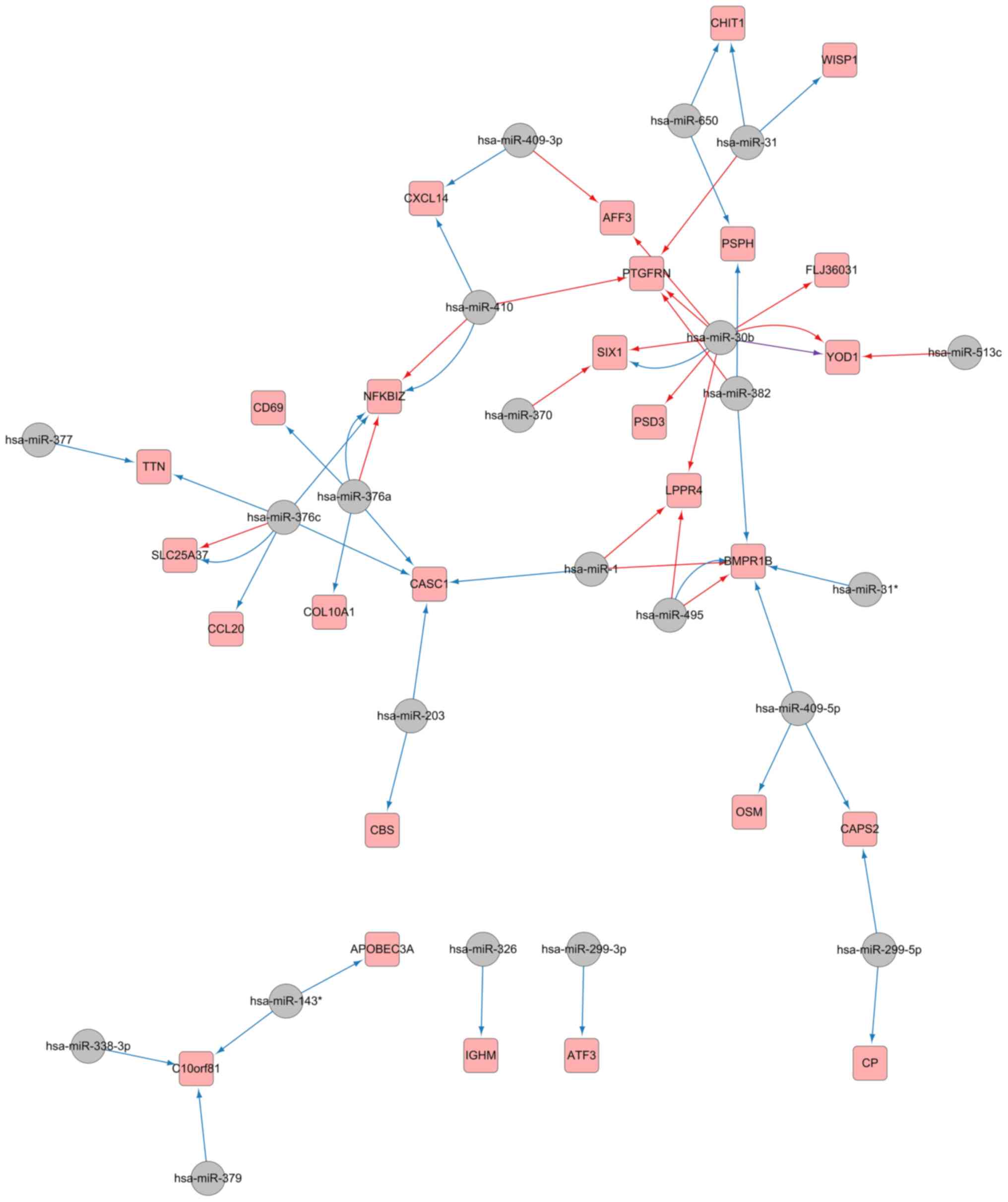|
1
|
Meltzer EB and Noble PW: Idiopathic
pulmonary fibrosis. Orphanet J Rare Dis. 3:82008. View Article : Google Scholar : PubMed/NCBI
|
|
2
|
Cai M, Zhu M, Ban C, Su J, Ye Q, Liu Y,
Zhao W, Wang C and Dai H: Clinical features and outcomes of 210
patients with idiopathic pulmonary fibrosis. Chin Med J (Engl).
127:1868–1873. 2014.PubMed/NCBI
|
|
3
|
Ley B, Collard HR and King TE Jr: Clinical
course and prediction of survival in idiopathic pulmonary fibrosis.
Am J Respir Crit Care Med. 183:431–440. 2011. View Article : Google Scholar : PubMed/NCBI
|
|
4
|
King TE Jr, Pardo A and Selman M:
Idiopathic pulmonary fibrosis. Lancet. 378:1949–1961. 2011.
View Article : Google Scholar : PubMed/NCBI
|
|
5
|
Rajasekaran S, Rajaguru P and Sudhakar
Gandhi PS: MicroRNAs as potential targets for progressive pulmonary
fibrosis. Front Pharmacol. 6:2542015. View Article : Google Scholar : PubMed/NCBI
|
|
6
|
Zhu W and Chen YP: Computational
developments in microRNA-regulated protein-protein interactions.
BMC Syst Biol. 8:142014. View Article : Google Scholar : PubMed/NCBI
|
|
7
|
Meltzer EB, Barry WT, D'Amico TA, Davis
RD, Lin SS, Onaitis MW, Morrison LD, Sporn TA, Steele MP and Noble
PW: Bayesian probit regression model for the diagnosis of pulmonary
fibrosis: Proof-of-principle. BMC Med Genomics. 4:702011.
View Article : Google Scholar : PubMed/NCBI
|
|
8
|
Milosevic J, Pandit K, Magister M,
Rabinovich E, Ellwanger DC, Yu G, Vuga LJ, Weksler B, Benos PV,
Gibson KF, et al: Profibrotic role of miR-154 in pulmonary
fibrosis. Am J Respir Cell Mol Biol. 47:879–887. 2012. View Article : Google Scholar : PubMed/NCBI
|
|
9
|
Qiu X, Wu H and Hu R: The impact of
quantile and rank normalization procedures on the testing power of
gene differential expression analysis. BMC Bioinformatics.
14:1242013. View Article : Google Scholar : PubMed/NCBI
|
|
10
|
Fan S, Pan Z, Geng Q and Li X, Wang Y, An
Y, Xu Y, Tie L, Pan Y and Li X: Layered signaling regulatory
networks analysis of gene expression involved in malignant
tumorigenesis of non-resolving ulcerative colitis via integration
of cross-study microarray profiles. PLoS One. 8:e671422013.
View Article : Google Scholar : PubMed/NCBI
|
|
11
|
Fan S and Li X, Tie L, Pan Y and Li X:
KIAA0101 is associated with human renal cell carcinoma
proliferation and migration induced by erythropoietin. Oncotarget.
7:13520–13537. 2016.PubMed/NCBI
|
|
12
|
Fan S, Geng Q, Pan Z and Li X, Tie L, Pan
Y and Li X: Clarifying off-target effects for torcetrapib using
network pharmacology and reverse docking approach. BMC Syst Biol.
6:1522012. View Article : Google Scholar : PubMed/NCBI
|
|
13
|
Kutmon M, Kelder T, Mandaviya P, Evelo CT
and Coort SL: CyTargetLinker: A cytoscape app to integrate
regulatory interactions in network analysis. PLoS One.
8:e821602013. View Article : Google Scholar : PubMed/NCBI
|
|
14
|
Huang da W, Sherman BT and Lempicki RA:
Systematic and integrative analysis of large gene lists using DAVID
bioinformatics resources. Nat Protoc. 4:44–57. 2009. View Article : Google Scholar : PubMed/NCBI
|
|
15
|
Huang da W, Sherman BT and Lempicki RA:
Bioinformatics enrichment tools: Paths toward the comprehensive
functional analysis of large gene lists. Nucleic Acids Res.
37:1–13. 2009. View Article : Google Scholar : PubMed/NCBI
|
|
16
|
Maimaiti A, Abudoukeremu K, Tie L, Pan Y
and Li X: MicroRNA expression profiling and functional annotation
analysis of their targets associated with the malignant
transformation of oral leukoplakia. Gene. 558:271–277. 2015.
View Article : Google Scholar : PubMed/NCBI
|
|
17
|
Li Y, Xu J, Chen H, Bai J, Li S, Zhao Z,
Shao T, Jiang T, Ren H, Kang C and Li X: Comprehensive analysis of
the functional microRNA-mRNA regulatory network identifies miRNA
signatures associated with glioma malignant progression. Nucleic
Acids Res. 41:e2032013. View Article : Google Scholar : PubMed/NCBI
|
|
18
|
Dong L, Bi KH, Huang N and Chen CY:
Biological analysis of chronic lymphocytic leukemia: Integration of
mRNA and microRNA expression profiles. Genet Mol Res. 15:2016.
View Article : Google Scholar :
|
|
19
|
Zhu J, Wang S, Zhang W, Qiu J, Shan Y,
Yang D and Shen B: Screening key microRNAs for castration-resistant
prostate cancer based on miRNA/mRNA functional synergistic network.
Oncotarget. 6:43819–43830. 2015. View Article : Google Scholar : PubMed/NCBI
|
|
20
|
Li J, Fan S, Han D, Xie J, Kuang H and Ge
P: Microarray gene expression profiling and bioinformatics analysis
of premature ovarian failure in a rat model. Exp Mol Pathol.
97:535–541. 2014. View Article : Google Scholar : PubMed/NCBI
|
|
21
|
Liu PF, Jiang WH, Han YT, He LF, Zhang HL
and Ren H: Integrated microRNA-mRNA analysis of pancreatic ductal
adenocarcinoma. Genet Mol Res. 14:10288–10297. 2015. View Article : Google Scholar : PubMed/NCBI
|
|
22
|
Pandit KV, Corcoran D, Yousef H,
Yarlagadda M, Tzouvelekis A, Gibson KF, Konishi K, Yousem SA, Singh
M, Handley D, et al: Inhibition and role of let-7d in idiopathic
pulmonary fibrosis. Am J Respir Crit Care Med. 182:220–229. 2010.
View Article : Google Scholar : PubMed/NCBI
|
|
23
|
Pandit KV, Milosevic J and Kaminski N:
MicroRNAs in idiopathic pulmonary fibrosis. Transl Res.
157:191–199. 2011. View Article : Google Scholar : PubMed/NCBI
|
|
24
|
Yang S, Banerjee S, de Freitas A, Sanders
YY, Ding Q, Matalon S, Thannickal VJ, Abraham E and Liu G:
Participation of miR-200 in pulmonary fibrosis. Am J Pathol.
180:484–493. 2012. View Article : Google Scholar : PubMed/NCBI
|
|
25
|
Cushing L, Kuang PP, Qian J, Shao F, Wu J,
Little F, Thannickal VJ, Cardoso WV and Lü J: miR-29 is a major
regulator of genes associated with pulmonary fibrosis. Am J Respir
Cell Mol Biol. 45:287–294. 2011. View Article : Google Scholar : PubMed/NCBI
|
|
26
|
Wang Y, Huang C, Reddy Chintagari N,
Bhaskaran M, Weng T, Guo Y, Xiao X and Liu L: miR-375 regulates rat
alveolar epithelial cell trans-differentiation by inhibiting
Wnt/β-catenin pathway. Nucleic Acids Res. 41:3833–3844. 2013.
View Article : Google Scholar : PubMed/NCBI
|
|
27
|
Yang S, Cui H, Xie N, Icyuz M, Banerjee S,
Antony VB, Abraham E, Thannickal VJ and Liu G: miR-145 regulates
myofibroblast differentiation and lung fibrosis. FASEB J.
27:2382–2391. 2013. View Article : Google Scholar : PubMed/NCBI
|
|
28
|
Nho RS, Im J, Ho YY and Hergert P:
MicroRNA-96 inhibits FoxO3a function in IPF fibroblasts on type I
collagen matrix. Am J Physiol Lung Cell Mol Physiol. 307:L632–L642.
2014. View Article : Google Scholar : PubMed/NCBI
|
|
29
|
Liang H, Xu C, Pan Z, Zhang Y, Xu Z, Chen
Y, Li T, Li X, Liu Y, Huangfu L, et al: The antifibrotic effects
and mechanisms of microRNA-26a action in idiopathic pulmonary
fibrosis. Mol Ther. 22:1122–1133. 2014. View Article : Google Scholar : PubMed/NCBI
|
|
30
|
Dakhlallah D, Batte K, Wang Y,
Cantemir-Stone CZ, Yan P, Nuovo G, Mikhail A, Hitchcock CL, Wright
VP, Nana-Sinkam SP, et al: Epigenetic regulation of miR-17~92
contributes to the pathogenesis of pulmonary fibrosis. Am J Respir
Crit Care Med. 187:397–405. 2013. View Article : Google Scholar : PubMed/NCBI
|
|
31
|
Yang G, Yang L, Wang W, Wang J, Wang J and
Xu Z: Discovery and validation of extracellular/circulating
microRNAs during idiopathic pulmonary fibrosis disease progression.
Gene. 562:138–144. 2015. View Article : Google Scholar : PubMed/NCBI
|
|
32
|
Frick VO, Rubie C, Keilholz U and Ghadjar
P: Chemokine/chemokine receptor pair CCL20/CCR6 in human colorectal
malignancy: An overview. World J Gastroenterol. 22:833–841. 2016.
View Article : Google Scholar : PubMed/NCBI
|
|
33
|
Cheluvappa R: Experimental appendicitis
and appendectomy modulate the CCL20-CCR6 axis to limit inflammatory
colitis pathology. Int J Colorectal Dis. 29:1181–1188. 2014.
View Article : Google Scholar : PubMed/NCBI
|
|
34
|
Marchal-Sommé J, Uzunhan Y, Marchand-Adam
S, Kambouchner M, Valeyre D, Crestani B and Soler P: Dendritic
cells accumulate in human fibrotic interstitial lung disease. Am J
Respir Crit Care Med. 176:1007–1014. 2007. View Article : Google Scholar : PubMed/NCBI
|
|
35
|
O'Hara KA, Kedda MA, Thompson PJ and
Knight DA: Oncostatin M: An interleukin-6-like cytokine relevant to
airway remodelling and the pathogenesis of asthma. Clin Exp
Allergy. 33:1026–1032. 2003. View Article : Google Scholar : PubMed/NCBI
|
|
36
|
Mozaffarian A, Brewer AW, Trueblood ES,
Luzina IG, Todd NW, Atamas SP and Arnett HA: Mechanisms of
oncostatin M-induced pulmonary inflammation and fibrosis. J
Immunol. 181:7243–7253. 2008. View Article : Google Scholar : PubMed/NCBI
|
|
37
|
Josson S, Gururajan M, Hu P, Shao C, Chu
GY, Zhau HE, Liu C, Lao K, Lu CL, Lu YT, et al: miR-409-3p/-5p
promotes tumorigenesis, epithelial-to-mesenchymal transition, and
bone metastasis of human prostate cancer. Clin Cancer Res.
20:4636–4646. 2014. View Article : Google Scholar : PubMed/NCBI
|













